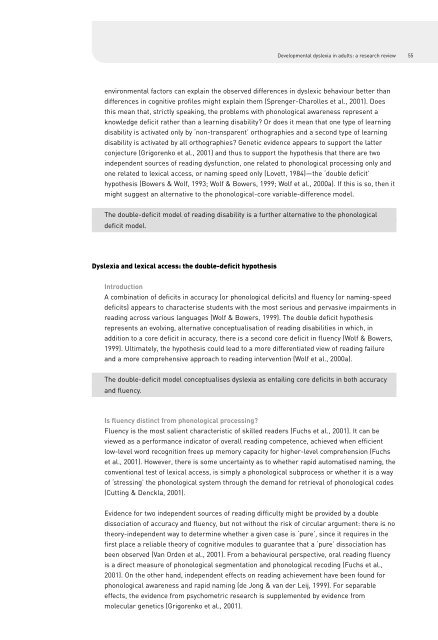01 NRDC Dyslexia 1-88 update - Texthelp
01 NRDC Dyslexia 1-88 update - Texthelp
01 NRDC Dyslexia 1-88 update - Texthelp
You also want an ePaper? Increase the reach of your titles
YUMPU automatically turns print PDFs into web optimized ePapers that Google loves.
Developmental dyslexia in adults: a research review 55<br />
environmental factors can explain the observed differences in dyslexic behaviour better than<br />
differences in cognitive profiles might explain them (Sprenger-Charolles et al., 20<strong>01</strong>). Does<br />
this mean that, strictly speaking, the problems with phonological awareness represent a<br />
knowledge deficit rather than a learning disability? Or does it mean that one type of learning<br />
disability is activated only by ‘non-transparent’ orthographies and a second type of learning<br />
disability is activated by all orthographies? Genetic evidence appears to support the latter<br />
conjecture (Grigorenko et al., 20<strong>01</strong>) and thus to support the hypothesis that there are two<br />
independent sources of reading dysfunction, one related to phonological processing only and<br />
one related to lexical access, or naming speed only (Lovett, 1984)—the ‘double deficit’<br />
hypothesis (Bowers & Wolf, 1993; Wolf & Bowers, 1999; Wolf et al., 2000a). If this is so, then it<br />
might suggest an alternative to the phonological-core variable-difference model.<br />
The double-deficit model of reading disability is a further alternative to the phonological<br />
deficit model.<br />
<strong>Dyslexia</strong> and lexical access: the double-deficit hypothesis<br />
Introduction<br />
A combination of deficits in accuracy (or phonological deficits) and fluency (or naming-speed<br />
deficits) appears to characterise students with the most serious and pervasive impairments in<br />
reading across various languages (Wolf & Bowers, 1999). The double deficit hypothesis<br />
represents an evolving, alternative conceptualisation of reading disabilities in which, in<br />
addition to a core deficit in accuracy, there is a second core deficit in fluency (Wolf & Bowers,<br />
1999). Ultimately, the hypothesis could lead to a more differentiated view of reading failure<br />
and a more comprehensive approach to reading intervention (Wolf et al., 2000a).<br />
The double-deficit model conceptualises dyslexia as entailing core deficits in both accuracy<br />
and fluency.<br />
Is fluency distinct from phonological processing?<br />
Fluency is the most salient characteristic of skilled readers (Fuchs et al., 20<strong>01</strong>). It can be<br />
viewed as a performance indicator of overall reading competence, achieved when efficient<br />
low-level word recognition frees up memory capacity for higher-level comprehension (Fuchs<br />
et al., 20<strong>01</strong>). However, there is some uncertainty as to whether rapid automatised naming, the<br />
conventional test of lexical access, is simply a phonological subprocess or whether it is a way<br />
of ‘stressing’ the phonological system through the demand for retrieval of phonological codes<br />
(Cutting & Denckla, 20<strong>01</strong>).<br />
Evidence for two independent sources of reading difficulty might be provided by a double<br />
dissociation of accuracy and fluency, but not without the risk of circular argument: there is no<br />
theory-independent way to determine whether a given case is ‘pure’, since it requires in the<br />
first place a reliable theory of cognitive modules to guarantee that a ‘pure’ dissociation has<br />
been observed (Van Orden et al., 20<strong>01</strong>). From a behavioural perspective, oral reading fluency<br />
is a direct measure of phonological segmentation and phonological recoding (Fuchs et al.,<br />
20<strong>01</strong>). On the other hand, independent effects on reading achievement have been found for<br />
phonological awareness and rapid naming (de Jong & van der Leij, 1999). For separable<br />
effects, the evidence from psychometric research is supplemented by evidence from<br />
molecular genetics (Grigorenko et al., 20<strong>01</strong>).
















